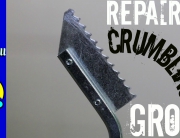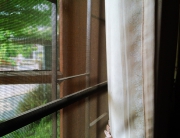February 3, 2015 How to Install a Slate Tile Floor
A Written How-to Guide To Accompany the See Jane Drill Videos: Laying Slate Tile in Thinset and How to Grout Slate Tile
Tools & Supplies Needed to Complete the Job
o Power drill with mixing wand (a bucket trowel can also be used for mixing)
o Acrylic thinset (also called mortar) that is formulated for use with natural stone
o Paint Scraper
o Notched Trowel
o Piece of chalk for marking
o Large bucket with plenty of clean water
o Large sponge or two (Be sure to get good sponges for this job)
o Spacers that are at least ¼ inch
o Sealer for natural stone floors
o Knee pads
o Grout, in the color of your choice
o Trowel float
o Margin trowel float
o Rubber gloves
Special Requirements
It is advisable to apply an anti-fracture membrane before installing the tile, if you are working with a concrete or cement substrate. This membrane is available in paste, sheet or liquid form. The liquid form is the easiest to apply. You may also consider applying this membrane for an added layer of protection with other types of substrate, such as brick or sheetrock.
Steps to Lay a Tile Floor
1. Strike your line and lay the first tile: To review how to strike your line and determine where to lay your first tile, watch the video “How to Lay Out Floor Tile.”
2. Make sure that you are laying tile down on a clean sub-surface. Apply an anti-fracture membrane to the substrate if it is concrete or cement (see Special Requirements, above)
3. Mix your thinset in a bucket, per the manufacturer’s instructions.
4. Dry-fit the first few tiles along your chalk line to make sure they are properly spaced and even. If you are working with un-gauged tile, you may notice slight variations in height between two adjacent tiles. If the variation is noticeable, mark the tile that is shorter with your chalk, so that you can make up the difference by applying additional thinset to the underside of the corner of that tile (also called “back-buttering” the tile)
5. Apply your mortar generously to the substrate for the first row of tiles. Take a big scoop of it with your bucket trowel, and apply it. First, spread it out with the smooth side of your notched trowel. Get it as close to the chalk line as you can without going outside the chalk line. You do, however, want to spread it out beyond the area of the first row of tiles into the area where the next row will be.
6. Next, turn the trowel around so that you are using the notched side of the trowel, to put grooves into the thinset. The air in these grooves will create a suction that helps to secure the tiles firmly in place. Be sure to draw your trowel across the thinset in the same direction in which you spread out the thinset with the smooth side of the trowel.
7. Now, you are ready to lay the first tiles. Be certain to take note of any tiles that you have marked with your chalk as requiring “back-buttering”, and apply additional thinset to the back side of the corner of the tile, right before laying that tile.
8. Lay the first tile in place. Put a bit of pressure on it with your hands and wiggle it back and forth a bit to set it.
9. Before setting the second tile, be sure to spread out any overflow of thinset from the first tile with the notched side of your trowel. Lay the second tile in the same manner as the first.
10. Install spacers to separate the two tiles.
11. Make any adjustments needed to ensure that the tiles are as even as possible.
12. When you have finished installing your first row, be sure to clean up any thinset that has spilled over the line onto the sub-floor, before it dries, so that the next row of tiles will lie flat.
13. Continue on until the entire floor is tiled.
Grouting and Sealing the Slate Tile Floor
1. Ensure that your tile floor is dry and clean, and that there is no thinset anywhere on the tiles.
2. Treat the tile with the sealer and allow to dry before beginning to grout. This very important, as the sealer will act as a “release” for the grout which gets on top of the tiles, making the clean-up process go much easier and more quickly.
3. Work on a small area at a time. This is very important. The largest area you will want to work at a time is about 3’ x 3’.
4. Mix the grout per the manufacturer’s instructions, to about the consistency of toothpaste.
5. Add a couple of scoops of grout to the tile surface.
6. Holding your trowel float at a 45 degree angle, work the grout into the tile joints by moving the trowel across the tile. Be sure you are moving the float diagonally into the joints, to ensure the best coverage.
7. Once you have forced as much grout as possible into the joints, it is time to remove the grout from the surface.
8. Holding your float at a 90 degree angle, begin scraping off the excess grout. Continue to work diagonally across the joints, as you did when applying the grout. Remove as much surface grout as possible, as this will make it much easier for you to clean the surface with your sponge later.
9. To remove grout from the natural crags in the surface of the stone, use the small margin float.
10. Next, clean up the remaining grout from the surface of the tile with a damp sponge. Be certain that your sponge is damp (wrung out) and not soaking wet, as you don’t want to remove the grout that is inside the joints. You will have to go over it several times with the sponge, and also change your water several times.
11. Once the grout has set (it doesn’t have to be completely cured yet, just dry) and the surface of the stone is dry, you will need to buff the surface of the stone to remove the remaining haze. The best cloth to use for this is an old terrycloth towel.
12. After the grout has set for 24-48 hours, you will need to seal the grout lines with your sealer. And if you are working with natural stone such as slate, you will need to seal the entire surface of the stone. Just follow the manufacturer’s instructions for the sealer that you are working with.
And that’s it! You did it! You have just installed a slate tile floor!
By See Jane Drill
Copyright 2014, All Rights Reserved
Due to differing conditions, tools, and individual skills, See Jane Drill assumes no responsibility for any mistakes, damages, injuries suffered, or losses incurred as a result of following the information published on our website and in the videos and written instructions published through our website. Before beginning any project, review the instructions carefully, and if you still have any doubts or questions about how to complete the project, consult with local experts or authorities. Also, because codes and regulations vary greatly by location, you should check to ensure that your project complies with all applicable local codes and regulations. Always read and follow all the safety precautions provided by any tool or equipment manufacturer, and follow all accepted safety procedures.
See Jane Drill is dedicated to providing accurate and helpful do-it-yourself information. We welcome your questions, input and feedback about the information provided on this website.
Click HERE for Printable Instructions







Leave A Comment